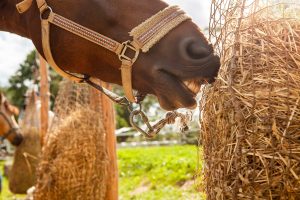Horses require different feeds for different stages of life. Make the switchover from one feed to another as seamless as possible with these tips.
Above all, make feed changes gradually.
Offering new feed can be approached in two ways: (1) taper off the old feed completely and then begin the new feed slowly, increasing intake 0.25-0.5 lb (0.1-0.3 kg) every two or three days, or (2) replace a portion of the old with the new, starting with about 10% of the feed and then increasing every few days.
“Slowly introducing new feed into the diet is important, as it allows the beneficial microbes in the digestive tract to adapt to the change,” said Ashley Fowler, Ph.D., a nutritionist at Kentucky Equine Research.
The beneficial microbes of the gastrointestinal tract have preferences for different substrates that provide the nourishment necessary for them to grow and flourish. When changing a horse’s feed, some microbes proliferate and others die off depending on the ingredients in the new feed and substrate availability. Rapid changes in the makeup of the microbial community could cause digestive upset, including colic or diarrhea, making slow introduction of new feed important.
“Further, horses have some ability to alter how well they digest and absorb nonstructural carbohydrates, primarily sugar and starch, based on their diet. Horses fed more nonstructural carbohydrates can increase the amount of glucose transporters in the small intestine over time. Without allowing time for the digestive tract to adapt, nonstructural carbohydrates may not be digested and absorbed as efficiently, which can cause overflow into the hindgut,” she explained.
When nonstructural carbohydrates arrive in the hindgut that has not been acclimated, they are rapidly fermented, resulting in increased volatile fatty acid production and a drop in pH, a condition termed hindgut acidosis. Targeted supplementation with EquiShure can mitigate the effects of hindgut acidosis. EquiShure is a time-released hindgut buffer designed specifically to combat hindgut acidosis in horses.
Take the time to weigh the new feed to ascertain any difference in the weight of old and new feeds.
Different feeds have different densities, meaning one scoop of feed may not weigh the same as another. Feeding directions on the bag or tag are often given in weights, so it is important to know what that weight looks like in the feed scoop you use.
Some horse owners find digital kitchen scales useful for weighing horse feeds, as they are inexpensive and easy to find.
“An easy way to make sure your horse gets the intended amount of feed is to make a mark on the feed scoop that corresponds to the correct amount, so you are feeding the same weight each time. Make sure to keep the scoop with the feed for which it is calibrated!” suggested Fowler
Depending on the nutritional composition of the feed you are introducing, the feeding rate may change. Some feeds have more concentrated nutrients than others, meaning you can feed less. Pay attention to the feeding directions on the bag to make sure your horse’s nutrient requirements are met.
Typically, grain meals should be limited to a maximum of 0.5 lb (0.23 kg) per 100 lb (45 kg) of body weight at each feeding, which is about 5 lb (2.3 kg) for a 1,000-lb (450-kg) horse. If you need to feed more than 5 lb (2.3 kg) per day, it is best to split the meal into two or more feedings. Large meals of starch and sugar can overwhelm the ability of the horse to digest and absorb these components, allowing them to reach the hindgut where they are rapidly fermented.
Be vigilant about feed refusal. Some horses take feed changes in stride, while others are far slower to acclimate. Check the feed tub daily for refusals.
Refusal of a new feed could indicate that the horse simply finds the new feed unpalatable. Sometimes a horse will warm up to a new feed if given time. Other horses can be persuaded to eat by adding appetizing flavors or favorite ingredients (molasses, applesauce, beet pulp).
“Feed form may also play a role in how well the horse eats its meals. Some horses simply prefer textured or pelleted feeds,” Fowler said. “Preferences also may be due to health concerns. Textured feeds with whole grains, for example, require more chewing power than pelleted feeds, so horses with dental issues may have a harder time finishing a meal of textured feed.”
If a horse leaves feed over the course of several weeks or months, it is not getting the proper amount of nutrients, potentially leading to unwanted weight loss or nutrient deficiencies, according to Fowler.
Be aware of any physical changes in the horse.
Feed allergies are uncommon in horses. Though rare, some horses can have allergic reactions to ingredients in feed, so hives that appear with a feed change could indicate an allergic reaction. Compare ingredients lists of the old and new feed and try to determine if the new feed contains an ingredient not in the old feed. Switching back to the old feed or performing an elimination diet may help you determine the source of the allergic reaction.
Loose manure or diarrhea may indicate digestive disturbances. Contact a veterinarian if you observe changes in your horse’s health that occur with feed changes.
Monitor behavior changes.
Horses fed high levels of sugar and starch, often required to fuel certain types of exercise, can have more energy as they become acclimated to the feed. Switching from a low-starch feed to a traditional feed may cause more reactive behavior. Some horses might benefit from extra pep in their step, but others may have more regulated behavior on a feed containing less starch and sugar and more fat and fermentable fiber.











